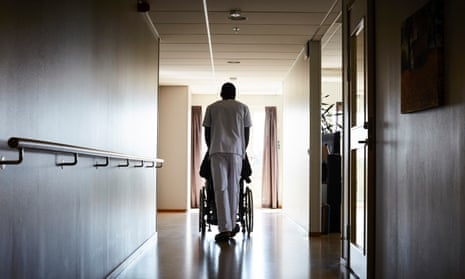“Doctor, what did they do to him? Dad just doesn’t look the same. Please help him!”
Of all the overnight admissions to the hospital, he looks the worst and the daughter’s cry pierces our heart.
A year ago, a prolonged surgery and trips back to theatre to battle the complications affected his memory such that his equally elderly wife was no longer able to care for his needs and he entered a nursing home.
One day, he develops a fever at the worst time, on a Friday afternoon. No doctor can visit him, and the nursing home quickly bundles him into an ambulance. The private hospital diagnoses a mild chest infection but now, it is Friday night, and the nursing home won’t have him back, citing a staff shortage. Under bright lights and noise, he becomes delirious.
That night, he is prescribed a “gentle” sedative and when he grows more confused, an antipsychotic is added on top of the sedatives he was already taking. Then, following his attempts to free himself from bed, the sedative doses are increased. By Wednesday, his situation is so dire that the private hospital transfers him out to the public hospital, citing a lack of resources.
As if this chain of events isn’t galling enough, this is what happens next.
Shifted to another environment, his confusion worsens, and he takes a swipe at the “ants”. Thankfully, the astute resident who assesses him recognises that the answer to his problem is not more sedation but less. She correctly diagnoses that a dangerous cocktail of sedatives has caused a distressing, and potentially fatal, problem.
The dishevelled patient is lying on a mattress placed on the floor, but he is now so still that I check his pulse to ensure he is alive. His sunken face and unstained hospital gown are a reminder that he has not eaten in days. His daughter is a nurse who observes that her father’s entire demeanour changed when he was prescribed sedation at the nursing home.
The medication was initially charted as “prn”, pro re nata, Latin for when necessary, but within weeks, he was receiving nightly sedation because the staff said he slept better. Her initial relief was replaced by concern when she noticed that he had become slower, less engaged, and less confident walking.
Cognisant that he could have progressive dementia, she nevertheless felt that the onset of his symptoms coincided so strongly with sedation that it warranted a drug review, only to be told that that was a “medical decision”.
Given her stoic attempts to connect the dots, I feel contrite telling her that the geriatrician also agrees that her concern was justified. I make no promises as we set out to make things better.
He is assigned a senior nurse who gently reorientates him several times a day. A student coaxes him to eat and sit out of bed. As he regains alertness, she plays a repetitive game of cards, smiling that it’s either that or putting up with the wandering. His daughter comes in after work and thumbs through old photos with her father. She feeds him dinner before going home, and tired from the days’ activities, he falls asleep soundly, without sedation.
His dementia persists but his days aren’t as fraught. He is pleasant and calm and his daughter brands his recovery a miracle but what I see is that just like raising a child, it took a village to wean him off potent sedatives that were causing more harm than good.
It is no surprise that this kind of involved care is simply unavailable in nursing homes.
Antipsychotics, traditionally used for schizophrenia, are now commonly used for the behavioural symptoms of dementia. They show modest efficacy at best but often cause confusion and somnolence. Benzodiazepines are prescribed for insomnia, anxiety and agitation. While they can be effective in the short term, they are associated with the risk of confusion, falls and dependence.
The aged care royal commission singled out the use of chemical restraints as an area of immediate action. It is estimated that roughly 10% of residents require some form of sedation to preserve their wellbeing but far, far more are prescribed drugs to make them more pliant.
Last week, the Australian Senate approved legislation mandating the round-the-clock presence of a registered nurse in every nursing home. But given the protean vulnerabilities of residents, it is hard to imagine one nurse shouldering the whole burden of supervising sedation. Add the healthcare skills shortage to warnings that employing a registered nurse will make businesses unviable, and it’s doubtful that this change will be meaningful on its own.
Could there be a better model of care?
Australian researchers recruited 150 nursing homes containing more than 12,000 patients and found that at baseline, 37% of residents received daily sedation. Accounting for “as needed” sedation, the figure jumped to a worrying 54%. Next, they designed an interactive program to educate aged care workers about best practice in sedation. The results were impressive.
Forty-one per cent of participating nursing home residents either reduced or ceased sedatives compared to a 4% rate reported in routine practice. The drugs were not replaced by substitutes. Contrary to expectations, reducing sedation did not lead to worsening behaviour but in fact improved the capacity to engage. The reduction in drug use was sustained and, unsurprisingly, the workers liked the program.
A key element of success was the team of a “champion” nurse, pharmacist and doctor, each with a different perspective. One imagines that if the pharmacist asked, “Why is this patient on an antipsychotic?”, no one replied “Because the doctor said so”. And the nurse was elevated as a model of good practice. In other words, this was medical care that pushed hierarchy aside and put the patient at the centre.
Education, collaboration and the headspace to devote to an alarming healthcare practice that robs many elders of vitality and life in their twilight years – surely this is what we would all want for ourselves and our loved ones.
But I can’t help thinking that underlying all of this is another fundamental notion – that a society marks itself by how it cares for its elderly.
Here, the responsibility falls to each of us to regard our elders with respect, advocate for their rights and refuse to consign them to a forgotten existence in a nursing home, known miserably as God’s waiting room. This is the standard our elders deserve.
Ranjana Srivastava is an Australian oncologist, award-winning author and Fulbright scholar. Her latest book is called A Better Death

